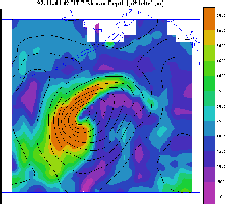PBL-LIB, the UW Planetary Boundary Layer Model


Jump to the source code links at the bottom
of this page.
Description of the Model
PBL-LIB is a collection of programs that deal with data pertaining to
the planetary boundary layer. Give the program BWIND four (or
at least one) geophysical parameters, and it can calculate a whole host
of other parameters, including:
- Surface wind speed (U10) and cross-isobar turning angle (alpha)
- Surface stress (u-star)
- Fluxes of sensible and latent heat
- Thermal wind in the PBL
- Ekman depth (pi * delta)
- Roughness length over water
- Stratification parameter z/L
- Geostrophic wind
- ...etc...
Click Here for a more technical
introduction, including references.
Links to the README files:
README :
README.bwind :
README.unbundle :
README.utils :
README.userIO
:
README.params :
BWIND needs only one (but would like four) parameters to run:
- Sea Level Pressure (to calculate winds; necessary)
- Near-sfc Air Temperature (for stratification correction and thermal wind)
- Surface Temperature (for stratification correction)
- Humidity or Dew Point (for latent heat flux)
To retrieve input data, there is a program called UNBUNDLE. It
currently reads from a variety of sources of data that can be obtained
from NCAR (ncardata.ucar.edu):
- NMC data:
- ds464.0: slp, sat and rlh, gridded to the 47 by 51 Octagon
- ds195.0: sst, gridded to the 47 by 51 Octagon
- ECMWF data:
- ds111.0: surface and upper air, T106/T63 spherical harmonic grid
- ds111.1: surface only, N80/N48 gaussian-latitude grid
- ds111.2: surface and upper air, 2.5 by 2.5 degree grid
UNBUNDLE extracts subregions of the entire grids, has the
option of interpolating to another grid, and writes them to a file in
the "pbl format" that BWIND expects. These are binary files;
for the exact specs, see the file called write_pbl.f.
You can use the subroutines write_pbl.f and
read_pbl.f to manipulate the data with your own programs
(or your own data display programs). Get the helpful file 'USER I/O'
along with the source code for some hints and help.
PBL-LIB consists of a series of programs written in FORTRAN 77 (and one in C)
for unix. Here is a list:
bwind
- calculates several PBL parameters. Reads the
input files from the subdirectory ../data/ and writes
its output to the same directory (both in
binary pbl-format).
unbundle
- extracts subsets of data (both in time and space) from
huge data files for use as input files for bwind.
Writes its output to the subdirectory ../data/ in
pbl-format.
pbl_to_asc
- translates pbl-format files into ASCII; default output
is to the screen. There are several switches. Use
the "-h" switch to list all the current options.
pbl_math
- performs elementary mathematical operations on a data
file, or point-by-point operations between two data
files (both files must be on the same grid). Use this
to scale a data file, find the difference between two
grids, etc.
pbl_ave
- averages the files you pass it (all files must be on
the same grid) and writes an output file.
pbl_find
- can find the high, the low, all values greater than a
given cutoff, all values less than a given cutoff, or
simply the value at a grid point in a data file.
pbl_plot
- plots the values of one file vs. the values of another.
Calls the program gnuplot. Can create postscript files.
pbl_uv2ma
- reads the u- and v-vector files and creates files of the
magnitude and angle (w.r.t. East). File name extensions
are of the form .??m and .??a, where the ?? is from the
vector (.??u and .??v).
pbl_density
- reads the slp, sat, and either rlh or dew files and calculates
the density of the near-surface air. Easier than running bwind on a
grid if that's the only output you need.
pbl_neutral
- reads a near-surface wind file of your choice (along with the sst, sat,
slp and either rlh or dew) and can either calculate the
neutral-equivalent wind or correct a neutral wind for stratification.
pbl_interp
- interpolates from any grid onto an equal-angle
(lat-lon) grid.
pbl_to_si
- creates a satellite-image file (pixels) for viewing in
satview*. Places the file in the subdirectory ../sat.
This program works on any grid, regardless of whether
or not it is an equal-angle (lat-lon) grid.
pbl_to_ov
- creates an overlay file (contours, vectors) for viewing
in satview*. Places the file in the subdirectory
../sat. The data file MUST be on an equal-angle
(lat-lon) grid, or you will get an output file filled
with garbage (with one exception: see the "irregular
vectors" option).
* Satview is a data display program developed at the University of
Washington; contact satview@atmos.washington.edu and/or look here for more information.
Of course, since this is a point model, the user can forgo the
"wrapper" and call the similarity model directly from his/her program.
The appropriate subroutine to call is brown.f and is
packaged in the source code for BWIND. It has a long section
of comments in the beginning describing each of the input and output
variables. You could call it at each grid point of your own model, if
you need one of the output variables.
View the Help File for Installing PBL-LIB at your site.
Get the source code for BWIND: a compressed .tar file or a .zip file
Get the source code for UNBUNDLE: a compressed .tar file or a .zip file
Get the source code for UTILITIES: a compressed .tar file or a .zip file
Get the helpful file USER I/O: a compressed .tar file or a .zip file
Get some Sample Input and Output Files: a compressed .tar file or a .zip file
Get some extra programs that calculate the profiles and hodographs of wind components, including secondary flow: a compressed .tar file or a .zip file
Back to the PBL Group page.
Back to the
UW Atmospheric Sciences home page.
Back to the
POLES Project Description page.
Since 29 Mar 96, Counter by http://www.digits.com/:

Comments to pbl-lib@atmos.washington.edu

